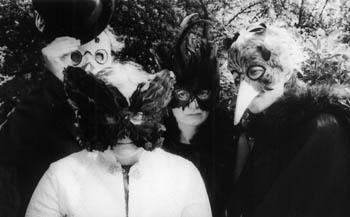![[Metroactive Music]](http://metroactive.com/music/gifs/music468.gif)
[ Music Index | San Jose | Metroactive Central | Archives ]
Musical Wonders
Pram is impish and macabre by turns on 'Museum of Imaginary Animals'
By Michelle Goldberg
ONE'S APPRECIATION for the English group Pram will likely depend on one's childhood. Those who spent much time bounding heartily about, basking in parental adoration and picking on bookworms may well find Pram's new record, The Museum of Imaginary Animals (Merge), impossibly precious and pallid.
But if Edward Gorey illustrated your early years, if you spent lots of time precociously curled up with novels, trying to practice witchcraft and dreaming of alternative fantasy lives in which your unique delicacy would be truly appreciated, then this musical wonder cabinet will almost certainly speak to you. The Museum of Imaginary Animals is impish and macabre, full of fairy tale loveliness and subtle terrors achieved with dazzling sonic eclecticism.
In many ways, Pram works in the same vein as Stereolab and Laika, both veterans of Pram's old British label, Too Pure. Founded in Birmingham in 1990 by Rosie Cuckston, the seven-person band combines laid-back pop with quirky, eccentric instruments like a homemade Theremin, zithers, glockenspiels and a Hawaiian bubble machine, as well as carefully deployed electronic effects.
Cuckston's lovely, vaguely affectless voice even recalls Stereolab's Laetitia Sadier, though with a slightly disturbed, shell-shocked undertone. And like Stereolab, past Pram albums (especially 1998's North Pole Radio Station) have flirted with easy-listening cocktail music and soundtracks--North Pole's "Omnichord" evinced a sultry, otherworldly feel that suggested Esquivel scoring David Lynch.
But while Stereolab's music has always been somehow public-spirited--the group has made albums for avant-garde gallery exhibitions, and Sadier's lyrics tend to veer among socially conscious agitprop, philosophy and playful surrealism--Pram prefers to probe the mind's cobwebbed corners, creating songs that are intensely intimate.
The band often employs toy instruments--and those that sound like toys--to fashion its warped, slightly sinister dreamscapes, giving some of its songs the quality of half-repressed memories. That's especially true on The Museum of Imaginary Animals, which demonstrates the band applying years of musical innovation to the themes that marked its 1992 debut EP, Gash, an alternately furious and funereal vision of childhood horror and helplessness that consisted solely of Cuckston singing over a Theremin.
Like Gash, The Museum of Imaginary Animals conjures sad girls brooding in lonely bedrooms or rummaging through attics. There's a distinctly gothic vibe throughout, one that's elegantly macabre rather than Marilyn Manson vulgar. The mood is immediately established with the song titles. There's "The Owl Service" (a name that seems inspired by the Harry Potter books), "Bewitched," "The Mermaids' Hotel" and "A Million Bubbles Burst."
THE LYRICS, TOO, suggest dark childhood reveries. On "The Owl Service," Cuckston sings, "The turnip moon makes a song of the lake/And all I know is heartache/The night is a tender velvet cloak/Lined in mist, edged in starlight."
"Bewitched" wryly and perfectly captures the particular tenor of a middle-class child's depression, with Cuckston delivering her lyrics in a breathy, Nico-like singsong: "No one ever said my life wasn't free/Or openly declared war on me/But a child's radar for signals from above/How to get or not get love."
But while Gash was spare and raw, The Museum of Imaginary Animals, like North Pole Radio Station, is precisely arranged, exquisitely detailed and gleaming. Gash sounded like the kind of music a miserable, introverted child would make, while The Museum of Imaginary Animals is an artist's rendering of a tormented early life. The new record suggests that Cluckston has established some distance from her primal inspirations, allowing for lightness, abstraction and even humor instead of just catharsis.
Though Pram's dominant attitude is one of shadowy magic and creepy whimsy, the band isn't afraid to employ wholly unexpected, incongruous ingredients like jazz, funk and even hip-hop in its compositions, which is part of what makes the record rich and enthralling instead of simply twee.
On "The Owl Service," an aggressive funk bass waltzes with girlish flutes, while exuberant trumpet stabs enliven "Bewitched." "Play of Waves" delivers straight-up jazz noir. "The Mermaids' Hotel" begins like a sci-fi hula, recapitulating ideas about kitsch dreams of paradise that have long fascinated the band.
Somehow, such elements never clash with the music-box melodies or crepuscular glow of the album. No matter how many discordant instruments appear, The Museum of Imaginary Animals remains consistently (though weirdly) beautiful. The Theremin, overused on previous Pram records, is deployed gorgeously on the wordless "Narwhal," its spooky hum sounding almost human.
Bells sparkle on the effervescent "Mother of Pearl" like sun glancing off the sea, while a frolicking horn provides ironic counterpoint to the song's despondent lyrics ("We need to creep around/The edges of our lives," Cuckston sings over a buoyant tune).
The songs are sometimes so ingratiating that they seem simple, but there's a lot going on beneath their placid surfaces. Like childhood itself in a way, Pram's world looks uncomplicated from a distance, but its frivolity is riddled with hallucinatory bogeymen and tiny melodramas.
[ San Jose | Metroactive Central | Archives ]
Copyright © 2000 Metro Publishing Inc. Metroactive is affiliated with the Boulevards Network.
For more information about the San Jose/Silicon Valley area, visit sanjose.com.
![]()

Instrumentalism: Zithers, glockenspiels, Theremins--the British group Pram never met an instrument it couldn't use.
From the September 28-October 4, 2000 issue of Metro, Silicon Valley's Weekly Newspaper.